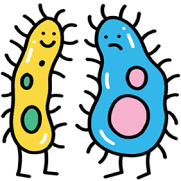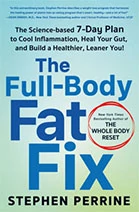AARP Hearing Center
By Stephen Perrine
Illustrations by Sam Island
Health
The 100 trillion microbes in your belly can keep you happy and healthy—if you feed them right.
By Stephen Perrine
Illustrations by Sam Island
As we get older, the ecosystem within our gut gets older, too. Decades of questionable food choices, a lack of exercise, and exposure to antibiotics and pesticides — which are, after all, designed to kill off microbes — can leave our microbiome weakened. (Indeed, just by looking at the gut, researchers can tell whether a person is on a path to frailty.)
The gut is the master controller of inflammation in the body. Weight gain, rising cholesterol levels, increased blood sugar — issues we associate with getting older — are, in many ways, indications of our microbiomes becoming less and less healthy. This is good news, actually. Because if you know how to eat to protect your microbiome, you may be able to pump the brakes on these age-related issues and stay healthier and more robust for longer.
All of which is relatively recent news to the medical community, including gastroenterologists — the very physicians who specialize in gut health.
“When I was first studying medicine at NYU in the 1990s, we were taught that the microbiome … is responsible for just one main task: digestion,” says Roshini Raj, M.D., associate professor of medicine at NYU Grossman School of Medicine and author of Gut Renovation. “Today, we’ve learned that the microbiome is, in many ways, the epicenter of our physical and emotional health.”
Imagine your gut as a tiny national park filled with thousands of diverse species that work together to maintain balance. About 85 percent of those species are beneficial to your health. If we don’t properly feed and nurture our gut, that balance can get thrown off; the diverse network of species begins to decline, and a coterie of unhealthy bacteria — including E. coli and H. pylori (which causes ulcers) — can start to take over. When that happens, chronic inflammation takes hold.
If you think that sounds bad, well, you’re right. Because, by controlling inflammation, a healthy microbiome plays an enormous role in just about every bodily system. For example, when your gut is balanced and healthy, you are more likely to:

In one study, researchers compared the microbiomes of 54 sets of twins; they found that the twin with the most variety in their microbiome was the one less likely to be overweight or obese.

Several studies have shown that the gut microbiomes of people with Alzheimer’s are significantly different from those with healthy brains; in a report in the journal Nutrition Reviews, researchers state that improving the gut microbiome might represent an effective strategy for preventing, or at least easing, Alzheimer’s symptoms.

A 2023 study of 195 people 100 and older living in Japan and Sardinia found that the microbiomes of these centenarians were healthier and more diverse than those of younger adults. Another study looked at the microbiomes of 728 female twins ages 42 to 86; it found that the less diverse a woman’s microbiome, the higher she scored on a frailty index. An unhealthy microbiome has been linked to an increased risk of atherosclerosis, diabetes, osteoporosis, muscle loss and autoimmune disease, among other longevity killers.

A 2020 study of 655 subjects found that those who had the highest levels of stress and anxiety and the lowest levels of social support showed the lowest levels of diversity in their microbiome. Other studies have found that our gut bacteria may play a role in our levels of self-esteem, our sociability, how well we sleep, our risk of alcoholism and even how likely we are to fall in love.
The vast majority of serotonin — the hormone that antidepressants are designed to boost — is generated by the microbes in our gut; and the microbiome communicates with the brain to stimulate the production of oxytocin, the “feel-good” hormone that’s released when we’re connecting with the people we love.
That’s more than enough reasons to make gut health a priority. So how are we doing?
Really, really badly.
All the little microbes in your gut are eager to help you quell inflammation, reduce your weight and slash your risk of disease — but they can’t do it alone. Here’s how you can help them.
A 2023 study found that when we eat a fiber-rich diet of whole foods, our microbiomes absorb more than 100 calories a day, and in some cases as much as 400 calories — calories that quite literally passed your lips but never made it to your hips. When we eat processed foods — which make up a whopping 60 percent of calories in the American diet — more of those calories go to us, not our microbiomes.
And when we don’t properly feed our microbiomes, they can’t be as effective at protecting our health. A 2022 study in JAMA Neurology found that adults who consumed 20 percent of their calories from ultraprocessed foods showed faster rates of cognitive and executive function decline compared with those who ate lower amounts. By contrast, another study published the same year found that those 60 and older who ate the most fiber-rich foods showed greater cognitive function than those who ate the least.
It’s not just the amount of fiber we eat, it’s the variety. Research by the UC San Diego Center for Microbiome Innovation found that the greater variety of plants your diet holds, the healthier your microbiome. Those with the healthiest microbiomes were people who ate at least 30 different types of plants — vegetables, whole grains, fruits, nuts, seeds and legumes — a week.
“Diversity drives diversity. If you only eat one type of fiber, you’re only going to feed one type of microbe,” says Maria Gloria Dominguez-Bello, a microbiologist at Rutgers University. She and her partner, Martin Blaser, M.D., also a microbiologist, strive to eat at least 20 different plants every single day.
Very few of us can achieve anything like that level of diversity in our diets. (By some estimates, 30 percent of the vegetables eaten by Americans are white potatoes.) But it is surprisingly fast and easy to spark change in the microbiome. In one experiment, Tim Spector, M.D., a genetic epidemiology professor at King’s College London, enlisted his son Tom to spend 10 days eating nothing but fast food. Tom took fecal samples before, during and after the 10-day period. Laboratory analysis revealed that more than 1,300 specific species of microbes had been essentially wiped out in just over a week.
Just as we can tear down our microbiomes quickly, we can rebuild them rapidly. (One study looked at people who ran a half-marathon and found that their microbiomes changed for the better over the course of a single race!)
The first step in rebuilding a healthier microbiome is to set a simple and reachable goal: Over the course of the next seven days, track how many different plants — whole grains, vegetables, nuts, fruits, seeds and legumes — you consume. If you eat the leaf, stem, grain, seed, fruit or root of the plant, it counts. (Processed foods such as fruit leather or white flour tortillas don’t.) Write them down.
Make it a competition: Can you eat more different plants than your friends or family? You might find you pass 30 in just a couple of days, or you might find toward the end of the week that you’ve got to get a little creative. But simply tracking how many different plants you eat over the next seven days can be an enormous first step. Simple steps like adding different fruits to your salad, eating the sides that come with your meal or throwing some grilled veggies on your sandwich can help get you to your goal.
Once you’ve learned to maximize the variety of plants you eat, you will have learned how to maximize the diversity of the microbes in your gut. And that will make them, and you, happier and healthier, for life.

Adapted from The Full-Body Fat Fix: The Science-Based, 7-Day Plan to Cool Inflammation, Heal Your Gut, and Build a Healthier, Leaner You! by Stephen Perrine (June 2024).